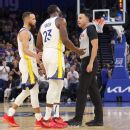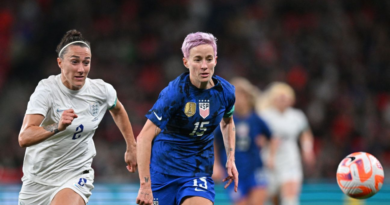NCAA: 3-point distances not accurate in Portland
PORTLAND, Ore. — The NC State Wolfpack‘s 76-66 win over the Texas Longhorns in Sunday’s Regional 4 final was played on a court with 3-point lines of different distances at the top of the key, the NCAA confirmed in a statement during halftime of the game.
“The NCAA was notified today that the 3-point lines on the court at Moda Center in Portland are not the same distance,” the statement said.
The error in the court, which had previously been used for four regional semifinals on Friday and Saturday, was discovered prior to Sunday’s game. The two head coaches, NC State’s Wes Moore and Texas’ Vic Schaefer, were notified with the countdown clock on ahead of the scheduled 12:16 p.m. start time. Video showed both coaches pacing off the distance to the painted 3-point lines at each end of the court.
According to Moore, the line in front of his team’s bench — the left side of the court on the television broadcast — was noticeably shorter than the standard distance of 22 feet, 1.75 inches from the center of the basket to the top of the arc, while the other 3-point line was correct.
NCAA representatives gave Moore and Schaefer the option of playing with the discrepancy in the 3-point lines or waiting for them to be remeasured and retaped, a process the coaches said would take more than an hour.
“At first Vic was hesitant about it,” Moore said, “and then he finally said, you know, ‘I didn’t want to wait an hour or something to play the game.’ I was ready to get going. But Vic probably figured out, you know what? This line down here is what we’re used to. That line down there isn’t.
“And if you’ll look, I think we shot the ball better on the other end both games, because that’s the normal line. But I’m not going to blame it on that. I mean, these kids, like I said, they shoot so far behind it sometimes nowadays, who knows where the line is?”
According to ESPN Stats & Information tracking, teams during the five games so far in the Portland regionals shot 29% (23-of-79) from the 3-point line that was too short, as compared to 33% (29-of-87) from the standard 3-point line. Additionally, teams averaged 66.8 points per game from the standard line and just 62.0 PPG from the shorter one.
Six of NC State’s nine 3-pointers on Sunday came from the standard line, including 5-of-5 shooting from leading scorer Aziaha James, who finished with a career-high seven 3s. James, who made a 3-pointer on Friday from logo distance, said it didn’t matter at all where the 3-point line was.
Because both teams would play one half with the correct 3-point line, there was no advantage to gain barring overtime, and that factored into the coaches’ decision to play rather than wait for a remeasurement.
“At the end of the day, we had already played a game on it,” Schaefer said. “We both won. So, we just decided to play.”
Still, both coaches expressed some degree of frustration that dealing with the discrepancy took them out of their usual pregame routine and put them behind schedule.
“I wish I hadn’t had known, to be honest with you,” Moore said.
Because the NCAA declined comment on how far off the 3-point line was pending an official measurement, the coaches were left to explain details of the situation left out of the statement in their postgame availability.
“Well, I hate to say this, but I have a lot of colleagues that would say, ‘Only in women’s basketball,'” Schaefer said. “I mean, it’s a shame, really, that it even happened. But it is what it is.
“I mean, I’m not the culprit here. You guys are asking me about something that I had no control over. So, Vic Schaefer ain’t the problem.”
An updated release postgame indicated that a vendor was responsible for the error and the NCAA “will investigate how this happened in the first place.” The lines and markings at the Moda Center will be remeasured and remarked after USC and UConn practice in the arena on Sunday night, in time for their Regional 3 final on Monday.
Lisa Peterson, chair of the Division I women’s basketball committee, told ESPN on Sunday it wasn’t clear whether the lines would be repainted or corrected with tape.
ESPN’s Alexa Philippou contributed to this report.




